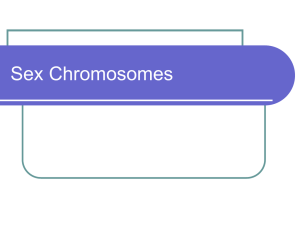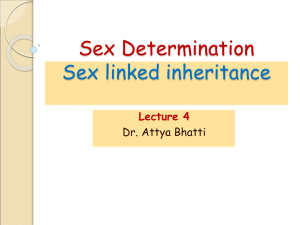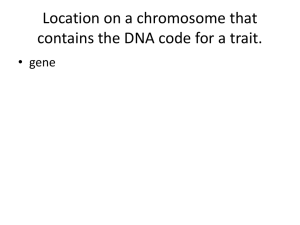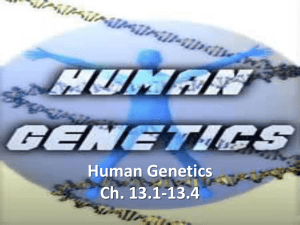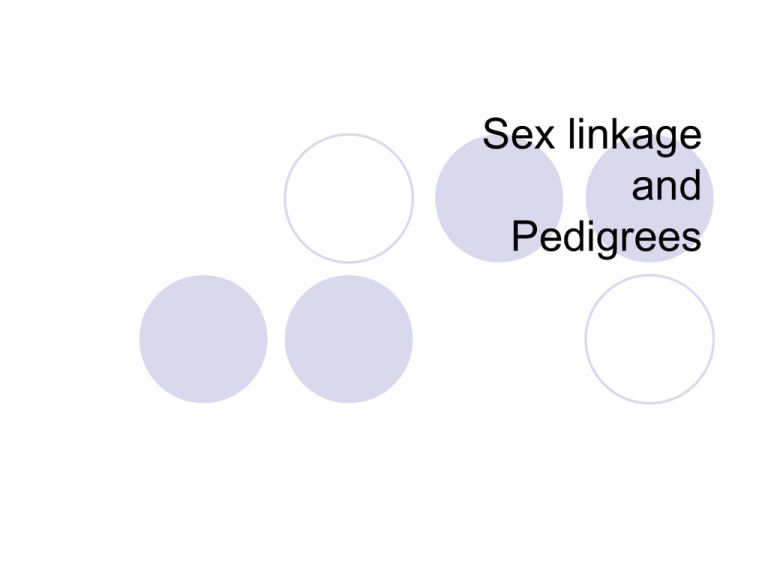
Sex linkage
and
Pedigrees
Sex determination in mammals
In humans and some other organisms, X and Y
chromosomes determine the sex of an individual.
This is because they carry certain genes that are critical
in sex determination, such as the SRY gene on the
mammalian Y chromosome, which controls testis
formation.
Individuals with two similar sex chromosomes are the
homogametic sex.
(i.e. women XX)
Individuals with different sex chromosomes are the
heterogametic sex.
(i.e. men XY)
During the growth and development of females’ cells,
one X chromosome can be inactivated in body cells.
The inactivated X chromosome is visible in a female’s
cells as a Barr body.
Sex determination in other organisms
WZ Chromosome System
Males are homogametic (ZZ) and females are heterogametic (ZW).
Birds and strawberries are examples of the W/Z determination.
XO Chromosome System
Only one sex chromosome.
Females are XX but males are XO, where the O refers to the absence of a matching
sex chromosome.
In the XO chromosome system diploid number is therefore even in females and odd
in males.
Sex Determination by haplodiploidy
Males develop from unfertilised eggs and are therefore haploid.
Females develop from fertilised eggs and are diploid. Examples include wasps and
bees.
Sex Determination by environmental factors
Environmental sex determination may depend on:
temperature (e.g. turtles, crocodiles)
day length (shrimp)
richness and availability of food resources (e.g. nematodes).
X linked inheritance
Males receive their X chromosome from their
mother – so they inherit all X-linked traits from
their mothers. The alleles on this chromosome
will determine the phenotype of X-linked traits
regardless of whether the trait is dominant or
recessive in heterozygous females.
All females inherit an X chromosome from each
parent. The random nature of X chromosome
inactivation means that heterozygous females
express different alleles in different cells.
X linked inheritance
X-linked Recessive
disorders
Show a pattern of
transmission of the mutant
phenotype from the female
parent to male offspring.
Only females may be
carriers of an X-linked
recessive trait.
Examples of X-linked
recessive disorders include
haemophilia A, haemophilia
C and red-green colour
blindness.
X linked inheritance
X-linked Dominant
disorders
Show a pattern of
transmission of the mutant
phenotype from an affected
male parent to all female
offspring, and from an
affected heterozygous
female parent to 50% of all
offspring.
Examples of X-linked
dominant disorders include
Vitamin D resistant rickets
and fragile X syndromes
Y linked inheritance
There are far fewer Y-linked than X-linked
genetic disorders
This is not surprising given that the Y
chromosome is smaller and has many
less genes than the X chromosome.
Y-linked inheritance shows a pattern of
transmission of the mutant phenotype
from father to son, and it is never
observed in females.
An example of a Y linked phenotypic trait
is hairy ears.
Sex limited inheritance
Y-linked inheritance is often confused with sexlimited inheritance.
Sex-limited traits can only occur in one sex
because the feature affected is unique to that
sex.
For example, premature baldness is an
autosomal dominant trait, but presumably as a
result of female sex hormones, the condition is
rarely expressed in the female, and then usually
only after menopause.
X-inactivation
During the growth and development of females’ cells,
one X chromosome can become inactivated in each
body cell.
The inactivated X chromosome is visible in a female’s
cells as a Barr body.
Which of the two X chromosomes becomes inactive in a
cell is a matter of chance, therefore heterozygous
females express different alleles in different cells.
This is generally not noticeable in the phenotype – for
example a woman heterozygous for the recessive
condition haemophilia A will produce sufficient clotting
factor VIII.
Tortoise shell cats are an example where X inactivation
is visible in the phenotype as one of the genes which
controls coat colour is sex-linked.
X-inactivation
One of the genes that controls coat colour in cats is sex-linked.
It has alternative alleles Xo (orange) and Xb (black)
Patches of cells in which the Xo are inactivated will produce dark fur.
Patches of cells in which the Xb is inactivated will produce orange fur.
Barr body
Pedigree Analysis
Is the technique of looking through a family tree (of humans or other
organisms) for the occurrence of a particular characteristic in one
family over a number of generations.
Can be used to determine the likely mode of inheritance:
Autosomal dominant
Autosomal recessive
X-linked dominant
X-linked recessive
When looking at pedigrees, incomplete penetrance is occasionally
observed.
Incomplete penetrance describes the situation where a proportion of a
population with a particular genotype does not show the expected
phenotype.
Complete penetrance of a phenotype means that all individuals with a
particular genotype will show the affected phenotype.
Symbols used in drawing pedigrees
Autosomal Dominant Pattern
An idealised pattern of inheritance of an autosomal dominant trait includes
the following features:
both males and females can be affected
all affected individuals have at least one affected parent
transmission can be from fathers to daughters and sons, or from mothers to
daughters and sons
once the trait disappears from a branch of the pedigree, it does not reappear
in a large sample, approximately equal numbers of each sex will be affected.
Examples include:
Huntington disease
Achondroplasia (a form of
dwarfism)
Familial form of Alzheimer
disease
Defective enamel of the
teeth
Neurofibromatosis (the
‘Elephant man’ disease)
Autosomal Recessive Pattern
An idealised pattern of inheritance of an autosomal recessive trait
includes the following features:
both males and females can be affected
two unaffected parents can have an affected child
all the children of two persons with the condition must also show the condition
the trait may disappear from a branch of the pedigree, but reappear in later
generations
over a large number of pedigrees, there are approximately equal numbers of
affected females and males.
Examples include:
Albinism
Cystic fibrosis
Thalassaemia
Tay-Sachs disease
Phenylketonuria
Red hair colour
X linked Dominant Pattern
An idealised pattern of inheritance of an X-linked dominant trait includes the
following features:
a male with the trait passes it on to all his daughters and none of his sons
a female with the trait may pass it on to both her daughters and her sons
every affected person has at least one parent with the trait
if the trait disappears from a branch of the pedigree, it does not reappear
over a large number of pedigrees, there are more affected females than males
Examples include:
Vitamin D resistant rickets
Incontinentia pigmenti, a
rare disorder that results in
the death of affected males
before birth
X linked Recessive Pattern
An idealised pattern of inheritance of an X-linked recessive trait includes the
following features:
all the sons of a female with the trait are affected
all the daughters of a male with the trait will be carriers of the trait and will not
show the trait; the trait can appear in their sons
none of the sons of a male with the trait and an unaffected female will show the
trait, unless the mother is a carrier
all children of two individuals with the trait will also show the trait
in a large sample, more males than females show the trait.
Examples include:
Ichthyosis, an inherited skin disorder
One form of red–green colour-blindness
One form of severe combined
immunodeficiency disease
Haemophilia
Fragile X syndrome
Duchenne muscular dystrophy
Is the condition observed in each generation of a family in which it occurs?
NO
YES
If daughters have the
condition does their
father also have it?
NO
Autosomal
recessive
Do males with the
condition who mate
with a normal female
have all daughters,
but no sons with the
condition?
ON
Is the condition
mainly in males?
Do only males have
condition, passing it
from father to son?
NO
YES
Sex-linked
recessive
Autosomal
dominant
YES
YES
Sex-linked
dominant
Y linkage
Linked Genes
Linkage is the tendency for two
or more genes located on the
same chromosome to be
inherited together.
The closer they are, the more
likely they are to be inherited
together.
Linkage is never complete
because of crossing over during
meiosis.
Linkage and the phenomenon of
crossing over can be used to
determine the distance between
genes on a chromosome.
Linked genes can be denoted in
the following ways when the
allele arrangements are known.
These include :
A b Ab/aB A b
aB
aB
Inheritance of linked genes
Assume two genes P and V
are linked:
gametes ½
PV
½
pv
½
PV
¼
¼
½
pv
¼
Parental cross
PV/PV x pv/pv
F1
All PV/pv
Will have dominant
phenotype
F2
PV/PV PV/pv
See punnet square to right
When crossing two F1
heterozygotes for two linked
gens, and disregarding
crossing over, the ratio of the
phenotypes is close to 3:1
¼
PV/PV pv/pv
Detecting Linkage
The results of test crosses between known double
heterozygote with a double homozygous recessive
allow us to determine if two gene loci are linked.
If the two gene loci are not linked, the genes will
assort independently and the outcome of the test
cross will be four classes of offspring in equal
proportions
If the two gene loci are linked, there will be four
classes of offspring but the proportions of these will
not be equal. Instead, there will be an excess of
offspring from parental gametes and a deficiency of
offspring from recombinant gametes.
Genes are ‘linked’ when the percentage of
recombinant gametes falls below 50%.
Estimating the distance between
linked genes
From the results of a test cross with linked
genes, it is possible to estimate the distance
between the gene loci.
This estimate is based on the percentage of
recombinant offspring.
Distance between loci = 100 ×
number of recombinant offspring
total number of offspring
The percentage of recombinant offspring
corresponds to the number of map units
separating the two genes.
Estimating the distance between
linked genes
There are 12 per cent total recombinant offspring, therefore the
loci of the two genes are separated by about 12 map units.
The chromosome make-up of the cross can be represented as:


